11.2 Using Remote Mode
Remote mode is familiar to GroupWise users who use Hit the Road. Similar to Caching mode, a copy of your network mailbox, or the portion of the mailbox you specify, is stored on your local drive. You can retrieve and send messages on a periodic basis with the type of connection you specify (modem, network, or TCP/IP). If you do not want a complete copy of your network mailbox, you can restrict what is retrieved, such as only new messages or only message subject lines.
Your GroupWise administrator can specify settings that do not allow you to use Remote mode.
11.2.1 Preparing to Use Remote Mode
Use Hit the Road on the Tools menu (or switch from Online mode to Remote mode) to create, set up, or update your Remote Mailbox. Your local mailbox is created on your local drive and any current connections are detected and set up. If you have already used Caching mode, your local mailbox has already been created.
You can also use Hit the Road to create setup files on a diskette to set up your Remote Mailbox on a computer that is not connected to the network.
Several users can set up their Remote Mailboxes on a single shared computer.
Setting Up Your Remote Mailbox
If you switch from Online mode to Remote mode, you can enter the path to the Remote Mailbox. If this path does not exist, Hit the Road runs automatically. The following steps explain how to set up your Remote Mailbox by using Hit the Road.
-
Make sure GroupWise is installed on the computer where you want to set up your Remote Mailbox.
-
Make sure you have a password on your Online Mailbox.
-
Run GroupWise in your office on your docked laptop or a workstation.
-
Click > .
-
Type your Mailbox password, then click .
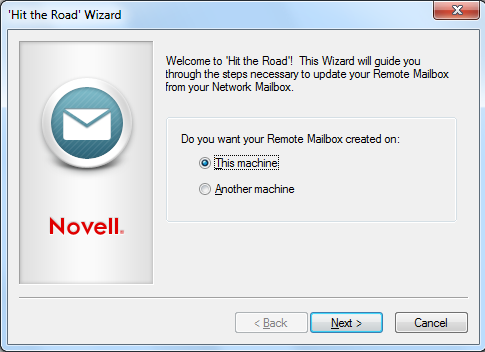
-
To create your Remote Mailbox on the docked laptop that is currently connected to the network with your Online GroupWise system, click , then click .
If you click and GroupWise is not installed on the docked laptop, you are prompted to install GroupWise. To use GroupWise away from your office, click to install GroupWise on the computer you’re traveling with. Continue with Step 7.
or
To create a setup diskette for another computer, such as your home computer, click , then click . Have a diskette ready. When your setup diskette is created, insert it into the computer where you want to set up your Remote Mailbox (such as your home computer), then run setup.exe from the diskette. Go to Step 10.
-
Type the path for your Remote Mailbox, then click .
-
Select the phone numbers you use to connect to your Online Mailbox, then click .
-
Select the items you want to copy to your Remote Mailbox, then click .
-
Exit GroupWise.
-
Right-click the Windows desktop, then click > .
-
Type c:\Program Files\Novell\GroupWise\grpwise.exe /pr-path_to_remote_mailbox. The path is the path you typed in Step 7.
-
Click .
-
Type a name for the shortcut, such as Remote.
-
Click .
After setting up your Remote Mailbox, you can begin sending and retrieving items and address book information from your Online Mailbox.
Setting Up Multiple Remote Mailboxes on a Shared Computer
These steps should be completed by each user who is setting up a Remote Mailbox on the shared computer.
-
Run GroupWise in Online mode, then click > .
-
If prompted, enter your password.
-
To create a Remote Mailbox setup diskette, click .
-
Follow the steps in the Hit the Road Wizard, inserting a blank diskette in the last step to save the setup files.
-
Log in to Windows on the shared computer, using a unique user name.
-
Insert the setup diskette into the shared computer, then run setup.exe from the diskette.
Make sure GroupWise is installed on the shared computer.
-
Select a folder for your Remote Mailbox files, then click .
This folder should not be shared with other users.
-
To run GroupWise against your Remote Mailbox, each user should log in to Windows with a unique user name before starting GroupWise.
Configuring Your Remote Connections
When you run GroupWise in Remote mode, you can connect to your Online GroupWise system through a modem connection, a network (direct) connection, or a TCP/IP connection. When you use Hit the Road to set up your Remote Mailbox, GroupWise creates the appropriate connections based on how you are currently running GroupWise. You can create new connections as well as change or delete existing ones.
Connections
You can switch among connection types if there are no pending requests on the connection you are switching from. For example, if you’re retrieving and sending items with a network connection and you disconnect before the transmission is complete, you should not switch to a modem connection to process the requests. Complete the original requests with the original connection.
Modem Connections
When you connect with a modem connection, you dial in to your Online GroupWise system over a phone line. You need to set up dialing information for each remote location. For example, in a hotel you often need to dial 9 to access an outside line, but at home you don’t. Each of these situations requires a separate remote location. For more information about setting dialing properties for each remote location, see your Windows documentation.
TCP/IP Connections
TCP/IP connections use an IP address and port to connect to your Online GroupWise system. If you use a toll-free Internet provider while you’re away from your office, you can avoid phone charges by using a TCP/IP connection. In addition, you don’t need to exit an Internet connection and hang up the phone to connect to your Online GroupWise system via a modem connection. You can use the same Internet connection to connect to your Online GroupWise system.
Network (Direct) Connections
When you’re at the office, you can run GroupWise in Remote mode with a network connection. A network connection is useful for quickly retrieving large amounts of information, such as your system address book.
Connection Status
When you use Hit the Road to update your Remote Mailbox before leaving the office or when you send and retrieve items remotely, the Connection Status window displays. This window lets you monitor the information transfer between your Online GroupWise system and your Remote Mailbox. To display detailed connection information, use . To display the number of requests the Online GroupWise system needs to process, use . To stop the information transfer anytime, use .
In addition to the Connection Status window, the icon in the Windows taskbar lets you know the status of your connection.
|
Icon |
Means |
|---|---|
|
|
You are connected. |
|
|
You are disconnected. |
|
|
You are sending items. |
|
|
You are receiving items. |
Connection Log
Use the Connection Log to display connection information and to troubleshoot connection problems. This log includes information about connection time, error messages, and so forth.
GroupWise uses three Connection Log files to log the connection information: remote1.log, remote2.log, and remote3.log. GroupWise uses the next log file each time you run GroupWise in Remote mode.
Creating a Modem Connection
Contact your GroupWise administrator for your gateway’s phone number, login ID, and password.
-
Click > > .
-
Click , click , then click .
-
Make sure is selected, then click .
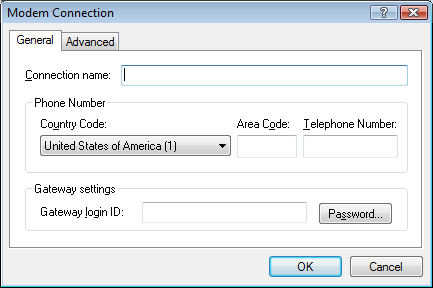
-
In the field, type a description.
-
Click the country code, then type the area code and phone number for the gateway to your GroupWise system.
-
Type the gateway login ID.
-
Click , type the gateway password, click , retype the password, then click .
-
Click the tab.
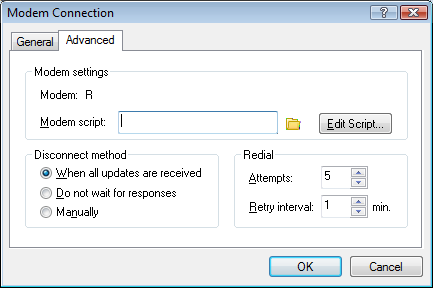
-
If your modem requires a script, click , then specify the necessary When Given and Respond With commands.
To save the script without changing its file name, click , then click .
or
To save the script with a new file name, click , then click .
-
To retrieve an existing script file, click
 , select the script file, then click .
, select the script file, then click .
-
Click a disconnect method.
-
In the field, specify the number of times to redial if the line is busy.
-
In the field, specify the time interval between each redial attempt.
-
Click , then click .
Creating a TCP/IP Connection
-
Click > > .
-
Click , click , then click .
-
Click , then click .
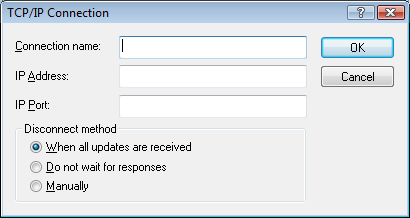
-
Type a descriptive name for the TCP/IP connection.
-
Type the IP address and port information provided by your GroupWise administrator.
Instead of an IP address, you can also type the DNS (Domain Name System) hostname in the field. Check with your GroupWise administrator.
-
Click a disconnect method, click , then click .
Creating a Network Connection
-
Click > > .
-
Click , click , then click .
-
Click , then click .
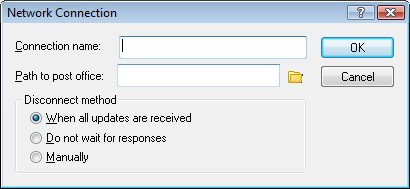
-
Type a descriptive name for the network connection.
-
Type the path to any post office directory in your GroupWise system.
Contact your GroupWise administrator for the path to your post office. You can also connect to any post office in your GroupWise system to access your Online Mailbox. You don’t need to connect to the post office containing your Online Mailbox.
-
Click a disconnect method, click , then click .
Copying a Remote Connection
-
Click > > .
-
Click , click , click the connection, then click .
-
Modify the connection, then click .
Editing a Remote Connection
-
Click > Send/Retrieve > .
-
Click , click , click the connection, then click .
-
Make the necessary changes, then click .
Deleting a Remote Connection
-
Click > > .
-
Click , click , then click the connection.
-
Click , then click .
Specifying Your Remote Location
-
Click > > , then click .
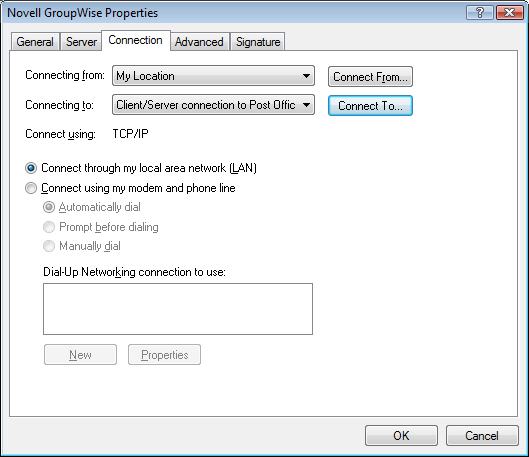
-
To select your remote location, click the drop-down list, then click the remote location.
-
To change the dialing properties of your modem, click , specify changes in the Dialing Properties dialog box, then click .
For help on specifying dialing properties, see your Windows documentation.
Specifying Remote Properties
You can change the way Remote mode is set up, including your connection, time zone, how often to send and retrieve items, system information, delete options, signature, and so forth, in Remote Properties. For information about changing your connections, see Configuring Your Remote Connections.
Specifying Time Zone Settings
The items in your Calendar are scheduled according to the time zone settings in the Windows Date/Time Properties. You can access this dialog box in Remote Properties on the tab. If you use GroupWise in another time zone, you can change to that new time zone so that your scheduled items reflect the time zone difference.
Typically, if you’re leaving your office for several days, you will use your Calendar information to attend and schedule appointments. Therefore, you need to use the local time zone. However, if you’re leaving your office for a short time, (for example, a day), you will probably keep the same time zone as your GroupWise system.
If you change time zone settings, be sure to change your computer’s clock to match the new time zone.
-
In Remote mode, click > , then double-click .
-
Click the remote account, click , then click the tab.
-
Click , click the current time zone, then click .
-
Click , click the tab, change your computer’s clock to match the new time zone, then click .
For more information about using Date/Time Properties, see your Windows documentation.
Sending and Retrieving Items at Regular Intervals
-
In Remote mode, click > , then double-click .
-
Make sure the remote account is marked with a check mark.
-
Click the .
-
Select , then specify the number of minutes.
-
Click .
For this option to work, your computer must stay connected to the network or phone line, depending on the connection you’re using.
To quickly turn this option on and off, click > . It is active when a check mark is displayed.
Specifying User and System Information for Your Remote Mailbox
-
In Remote mode, click > , double-click , then click .
-
In the field, type your first and last name.
This name appears in the field of an item you send someone. The name is also used as your user folder name.
-
Click .
-
Click the remote account, click , then click the tab.
-
Type your GroupWise user ID.
-
Type the domain name of your Online Mailbox.
-
Type the post office name of your Online Mailbox.
-
To change the password for your Online Mailbox, click , type your Online Mailbox password, then click . Specify the new password in both fields, then click .
If your administrator has turned on LDAP authentication, read and follow the additional information about your Online Mailbox password that is provided in this dialog box.
Your Online Mailbox must have a password before you can use Remote mode. If you have not assigned a password to your Online Mailbox, do so in Security Options while running GroupWise in your office.
Changing Remote Delete Options
By default, if you delete an item from your Remote Mailbox, the item is deleted from your Online mailbox the next time you connect. You can change the deletion options in Remote Properties so that an item deleted from your Remote Mailbox stays in your Online mailbox or vice versa.
-
Click > , then double-click .
-
Click the remote account, click , then click the tab.
-
Make your changes, then click .
HINT:This process does not apply to Caching mode. GroupWise automatically synchronizes the deletions between the Online and Caching modes.
Changing Your Signature
The signature you specify for Remote mode is the same signature that is used for Online mode. You can specify this signature in Remote Properties.
-
Click > , then double-click .
-
Click the remote account, click , then click the tab.
-
Change your signature text.
-
Click .
For more information about signatures, see Adding a Signature or vCard.
11.2.2 Setting a Remote Password
To use Remote mode, you must have a password set in Online mode. When you run in Remote Mode, you must use the same password as your Online Mailbox. For more information about passwords, see Section 1.3, Assigning a Password to Your Mailbox.
11.2.3 Understanding Remote Connection Types
When you run GroupWise in Remote mode, you can connect to your Online GroupWise system through a modem connection, a network (direct) connection, or a TCP/IP connection. When you use Hit the Road to set up your Remote Mailbox, GroupWise creates the appropriate connections based on how you are currently running GroupWise. You can create new connections as well as change or delete existing ones.
You will most likely use Remote away from the office with a computer that has no permanent network access. In these situations, you can use a TCP/IP connection or a modem connection to connect to your GroupWise system. Modem connections dial into a gateway in your GroupWise system. TCP/IP connections use unique IP (Internet Protocol) address and port information to connect to your GroupWise system.
You can also use Remote in your office and connect to your GroupWise System via a TCP/IP connection or a network drive mapping. These connections are useful to download large quantities of information, such as your system address book.
For more information, see Configuring Your Remote Connections.
If your remote connection is expensive, you can save money and connection time by connecting after peak business hours, downloading address books with a network connection prior to being on the road, restricting the messages you download, and waiting until you have a number of requests before connecting.
11.2.4 Understanding Remote Features
Most GroupWise features are available in Remote mode, with the exception of subscribing to other users’ notifications and Proxy.
11.2.5 Sending Remote Requests
Each time you send and retrieve messages, move items into folders, delete items, create rules, and so forth, the action is stored as a request. If you have made requests but exit GroupWise without connecting to your network mailbox, your pending requests are stored until the next time you run GroupWise, when you are prompted to complete the requests.
11.2.6 Processing Remote Requests
GroupWise automatically processes outstanding Remote requests when you run GroupWise on your docked laptop after you return to the office. For example, you might send an item while you are away from your office, but you don’t connect to the GroupWise system to process that request. When you return to the office and run GroupWise, you are asked if you want to process the outstanding requests. To see what requests still need to be processed, click .
11.2.7 Sending and Retrieving Items in Remote Mode
Use Send/Retrieve to synchronize your Online and Remote Mailboxes.
When you connect to your GroupWise system, items you sent from your Remote Mailbox are delivered to the recipients. Remote also sends a request to your Online Mailbox to retrieve your items, such as mail. Your GroupWise system processes the request, then sends your items to your Remote Mailbox, restricting the items according to the limits you set in the Send/Retrieve dialog box. In addition to items, you can retrieve rules, documents, and address books.
Connecting to GroupWise While Sending or Retrieving Messages
If you try to send or retrieve messages in Remote mode when you do not have a connection to GroupWise, a dialog box opens so you can select whether to connect now or connect later.You can also configure your connection before you connect.
Downloading Items, Rules, Addresses, and Documents to Your Remote Mailbox
-
If you’re running GroupWise in Online mode, click > , type your Online Mailbox password, select a connection phone number if prompted, then click .
or
If you’re running GroupWise in Remote mode, click > > .
-
To retrieve items, make sure is selected, click , click a tab if available, click an option, then click .
If you specify to limit the items you retrieve, for example, by selecting or setting size limits, you can download the rest of the item or items later. See Retrieving Items That Were Not Completely Downloaded.
If you are in Remote mode and only want to download new items, select on the tab.
-
Click .
-
To retrieve rules, click .
-
To retrieve addresses from the system Address Book, click , click , specify the addresses to retrieve, then click .
Because retrieving address books can take a long time with a modem connection, you should retrieve address books by using a network or TCP/IP connection.
For more information about filtering the GroupWise address book, see Filtering the GroupWise Address Book for Your Remote Mailbox.
-
To retrieve your personal address books, click .
-
To retrieve copies of GroupWise Library documents from your Online Mailbox, select the check box, click , select your documents, mark applicable documents as , then click .
Marking a document as In Use prevents others from modifying the document. If you don’t mark a document as In Use, someone can edit it while you have the copy in your Remote Mailbox. If you then edit the document and return it to the Master Library, your document is saved as a new version and the edits are not saved to the other version. If you don’t plan to edit a document, don’t mark it In Use.
When you exit an In Use document, you’re asked to send the document to the Master Library and mark it as Available. If you’re done with the document, the document should be marked Available to allow others editing access to it.
-
If you are in Remote mode and you want to specify your remote location and connection before downloading, click , select your remote location from the drop-down list, select a connection from the drop-down list, then click .
-
Click or .
If you are in Remote mode, all items in your list are sent at this time.
Sending Items in Remote Mode
-
Create a new item, then click on the toolbar.
Remote places the item in the list. When you connect to your master GroupWise system, all items in the list are sent.
-
Click > , then click the remote account.
or
If you want to specify your remote location and connection before sending the item, click > > , click , select your remote location from the drop-down list, select a connection from the drop-down list, click , then click .
At the same time your items are being sent, your new items are retrieved according to what you have specified in the Send/Retrieve dialog box.
You can switch between connection types (network, modem, and TCP/IP) if there are no pending requests on the connection you are switching from. For example, if you’re sending and retrieving items with a network connection and disconnect before the transmission is complete, you should not switch to a modem connection later to process the requests. Complete the original request with the original connection.
Viewing Pending Requests
Whenever you perform an action that requires information to be sent from your Remote Mailbox to your Online Mailbox, GroupWise creates a request that is placed in the list. When you connect to your master GroupWise system, all the requests are sent to your Online Mailbox. Use Pending Requests to check for outstanding requests.
-
Click > .
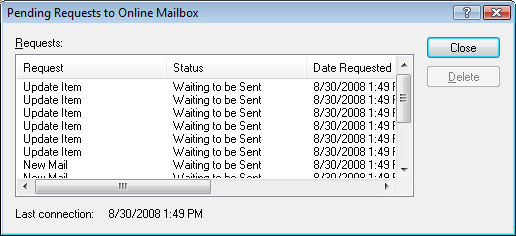
To prevent a request from being processed, click the request, then click . Only requests that haven’t been sent to the master GroupWise system and have the Waiting to be Sent status can be deleted. If you have already sent a request to the master GroupWise system, you cannot cancel the request.
Retrieving Items That Were Not Completely Downloaded
If you set size limit restrictions or specified Subject Line Only when you downloaded items, you might have items in your Remote Mailbox that are only partially downloaded.
-
Select the items in your Remote Mailbox.
-
Click > .
-
To connect immediately to your Online Mailbox, click .
or
To create the request but not send it, click . This way, you can wait until you have several requests before you connect.
Using Busy Search in Remote Mode
-
Create a new appointment.
-
To select the first possible meeting day, click
 , then click a date.
, then click a date.
-
Click on the toolbar.
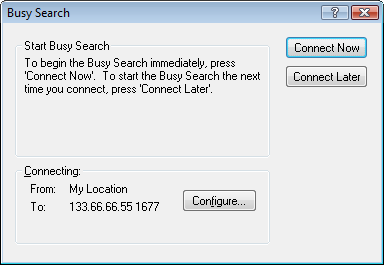
-
To immediately connect to your master GroupWise system and search for available times, click .
or
To search for available times later, click .
Clicking creates a busy search request, but doesn’t send the request to the master GroupWise system. You can save your appointment as a draft item in the Work In Progress folder until you are ready to send it. When you’re ready to check appointment times later, click , then click .
-
When the Choose Appointment Time window appears, click for the first available meeting time. Click until the best available time is displayed, then click .
or
Click the tab, click an available time, then click .
-
Complete the appointment, then click on the toolbar.
If you are disconnected before all schedule information returns from a busy search, clicking again lets you update the information from the original busy search request.
Filtering the GroupWise Address Book for Your Remote Mailbox
The GroupWise Address Book is usually large, because it contains information for your entire organization. If you don’t need all the information in the GroupWise Address Book when using GroupWise away from your office, use to retrieve only the user addresses, resource addresses, and public groups you need from the GroupWise system.
For example, the filter statement, Dept [ ] Marketing, instructs GroupWise to retrieve all addresses with “Marketing” in the Department column in the Address Book. This way you can contact anyone from your Marketing department while you’re traveling.
You should also retrieve GroupWise address book information before leaving your office to save downloading time and costs, especially if you’re planning to travel to a location where you will incur long-distance phone charges.
-
If you’re running GroupWise in Online mode, click > , type your Online Mailbox password, select a connection phone number if prompted, then click .
or
If you’re running GroupWise in Remote mode, click > > .
-
Click , then click .
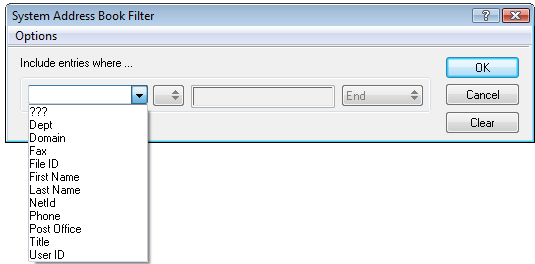
-
Click an Address Book column in the first drop-down list.
For example, click to search for addresses from a specific department.
-
Click the operator drop-down list, click an operator, then type your search criteria in the box or click a value, if provided.
For example, click , then type Accounts to search for addresses from the Accounts department. Use the operator that is most appropriate for your search. Your search criteria, such as a person’s name or a subject, can include wildcard characters such as an asterisk (*) or a question mark (?) Filter is not case sensitive to the criteria you type.
-
To add more filter conditions, click the last drop-down list, then click .
-
After specifying all filter conditions, read the text beginning with “Include entries where...” as you create your filter to understand how your filter will work.
-
Click , then click .
For more information on operators, see Using Advanced Find.
Deleting Items from Your Remote Mailbox
Use Delete and Empty and Manage Library Size to remove items from your Remote Mailbox.
Deleting Items from Your Remote Mailbox
In Remote mode, you can delete items, retract items, and empty the Trash the same way you would in the Online mode.
-
Click the item in your Mailbox.
-
Click > .
-
If you’re deleting an outgoing item, click one of the available options.
-
To free up disk space, click > .
This permanently removes all deleted items from your Remote Mailbox.
The next time you connect to your master GroupWise system, the changes in your Remote and Online Mailboxes automatically synchronize. You can turn off this synchronization by changing the delete options in Remote Properties. See Changing Remote Delete Options.
Deleting Unneeded Documents from Your Remote Library
Deleting files from your Remote Library Disk Space Management does not remove them from the Master Library. It also doesn’t remove the document references for the deleted documents. The files are removed only from the computer where you have your Remote Mailbox, freeing disk space for you.
-
In Remote mode, click > .
-
Click the documents you want to delete, then click .
-
When you’re done, click .
If you delete an In Use document, the status of the document in the Master Library is reset to Available the next time you connect to your Online Mailbox.
Document Reference Attachments and Remote Mode
You might receive an item with a document reference attachment when you are running in Remote mode. When you open the attachment, the document opens your Remote Library, even if the document in your Remote Library is an older version than the attachment. If the document does not exist in your Remote Library, you are prompted to connect now or later to your Online Mailbox to retrieve the document.
You can also send items with document reference attachments from Remote mode. However, if the document does not exist in your Remote Library, any recipients who do not have sufficient rights to the document in the Master Library or who are not using an email product that supports the GroupWise Library do not receive a copy of the document.
In addition, if the Master Library is unavailable, recipients do not receive a copy of the document. If any of these conditions exist, you need to attach an actual copy of the document in addition to the document reference.
11.2.8 Allowing Offline Send/Receive
-
Click > , then double-click .
-
Click the tab.
-
Select your allow level for Offline Send/Receive.
-
Click .



